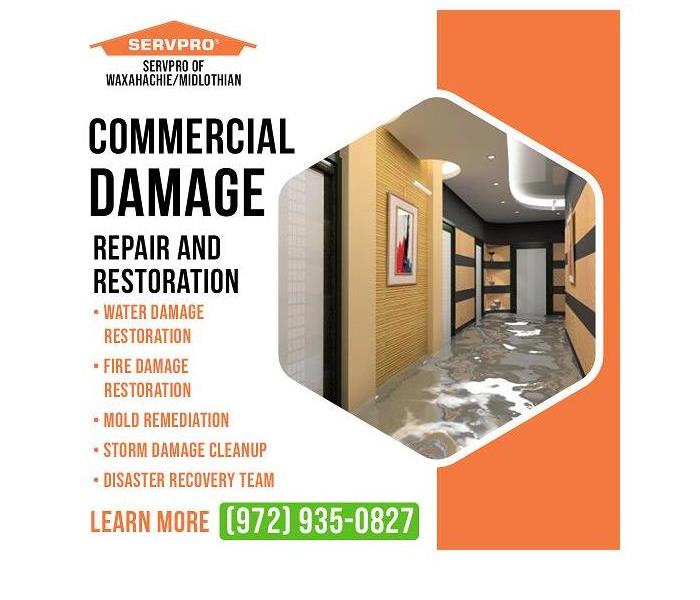Ten Tips to Help Local Business Owners Prepare for Flood Damage
4/12/2021 (Permalink)
Blog Summary: SERVPRO of Waxahachie / Midlothian urges local businesses to make flood damage preparations.
Waxahachie businesses are no strangers to commercial flood damage resulting from severe weather. In 2015, flood waters overflowed a portion of the downtown area. A local news outlet described the situation, stating, “It was a sleepless night for business owners and police in old Downtown Waxahachie. College Street flooded during the storm, stranding two motorists and forcing police to close a block of the road at the peak of the rainfall. Several businesses, a restaurant, and the police department took in water. Long-time residents say it was the worst flooding in at least a decade.”
In light of this disaster and the potential for more severe weather in the area, SERVPRO of Waxahachie / Midlothian urges business owners to follow the recommendations listed below to reduce the likelihood of flood damage to their businesses.
- Determine if the business is susceptible to flooding.
Check to see what flood zone the business is located in. Is the area prone to flooding? Learn the base flood elevation (BFE) for the property. The base flood elevation is the depth of floodwaters for a “100-year flood.” A business’s lowest floor needs to be three feet above the BFE to ensure that the structure is safe from flooding when severe weather strikes.
If the business is not located in a designated flood plain and has never historically suffered flood damage, then the location is most likely safe. However, area construction may have created new flood damage risks that the business owner needs to be aware of.
- Implement dry floodproofing strategies.
A building in or near a flood-prone area can utilize several dry floodproofing techniques to make the structure watertight and dry during a flood event.
- Stockpile flood-protective materials and products which aid in diverting water away from the building. Items include water-absorbent barriers and sandbags. Plastic sheeting or tarps are effective for relatively shallow flooding.
- Water-filled barriers that can be connected and stacked can be deployed at large commercial doors or entranceways that are exposed to deeper floodwaters.
- Install moveable flood gates, submarine doors, or permanent swing flood doors where the water depths are expected to be greater.
- Permanent flood walls that surround the entire structure may be necessary for areas where flooding is frequent, deep, and prolonged.
- Obtain flood insurance.
Businesses in or near a high-risk flood zone should purchase flood insurance. Flood insurance is provided through the federal National Flood Insurance Program (NFIP) and can be purchased through private insurance agents and companies.
- Landscape with native plants that will aid in flood water drainage.
Landscape with native plants and vegetation, which can help prevent soil erosion and allow floodwaters to drain more efficiently.
- Elevate electrical components, the HVAC system, and valuable records and documents above the BFE of the property.
Hire a licensed electrician to raise electrical switches, wiring, sockets, and circuit breakers at least one foot higher than the base flood elevation for the area. Following this tip will prevent flood waters from damaging the electrical system and will reduce the risk of fire from short circuits in flooded systems. Floodproof HVAC and ventilation equipment to prevent damage. Hire an HVAC contractor to relocate the equipment to an upper floor or enclose the systems with a floodproof wall.
- Add an extra layer of protection to the facility by using flood-resistant materials, sealing cracks, and applying a waterproof coating to walls.
In new construction and remodels, use flood-resistant materials where possible. Floor coverings, wall coverings, and wall insulation that is flood-resistant can withstand direct exposure to water and moisture for at least seventy-two hours without suffering significant damage.
- Invest in a generator and a sump pump.
Having backup electrical power can improve recovery time. Secure reserve power sources for any equipment deemed vital to resuming business operations. Install a sump pump with a battery backup, and include a sump pump backup that runs off of water pressure in case the power goes out or the influx of water exceeds what the primary unit can handle. Schedule regular maintenance and testing of the backup power system.
- Securely anchor fuel tanks.
Floating fuel tanks can damage buildings, vehicles, and equipment. If the tanks damage other properties or cause an environmental hazard, the business owner may face fines, property damage repairs, or litigation.
- Make sure that downspouts funnel water away from the building.
When downspouts fail to direct water a sufficient distance from the building’s foundation, the moisture can seep through the foundation, causing flooding, structural damage, and mold. If the area flooded is a basement or parking garage where equipment, products, and vehicles are kept, the impact could be catastrophic.
- Identify a damage restoration company that is highly experienced in commercial water damage restoration.
Prepare for any disaster by pre-qualifying a water, fire, smoke, and flood damage restoration company that can handle a commercial property damage incident. A flood damage disaster may involve fire, smoke, mold, and hazardous chemicals. Commercial cleaning services will be needed once the water is removed and the damage repaired. The environment must be safe, clean, and sanitary before operations can fully resume.
SERVPRO of Waxahachie / Midlothian has been providing commercial damage restoration services since 2000. The team of restoration experts specializes in residential, commercial, and large-scale disaster cleanup and restoration.
For more information about commercial damage restoration in Waxahachie, TX, contact the office by phone at (972) 935-0827 or email acarey@SERVPRO10932.com.



 24/7 Emergency Service
24/7 Emergency Service
